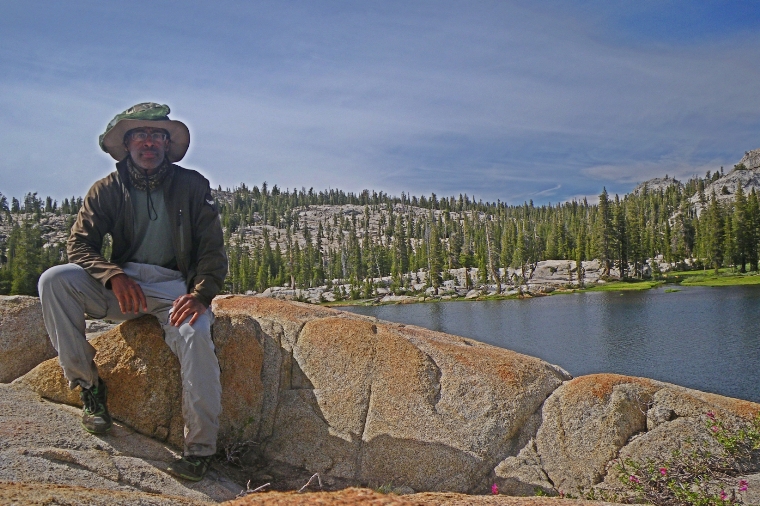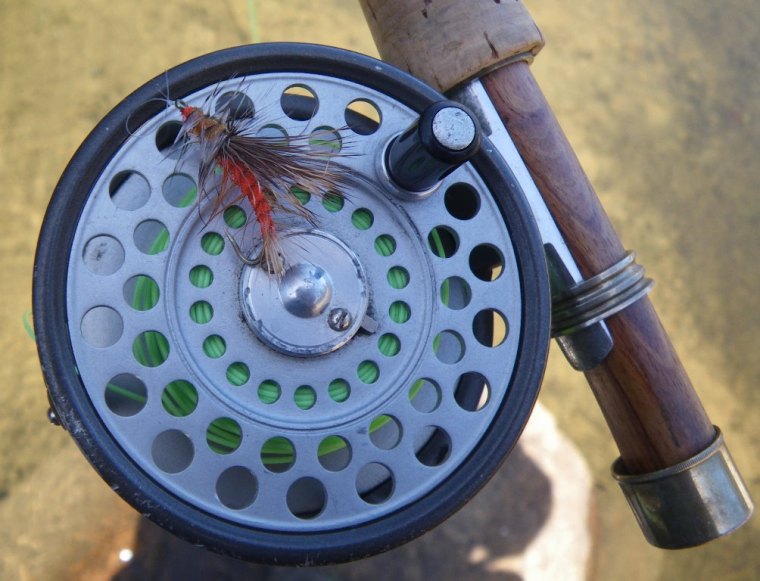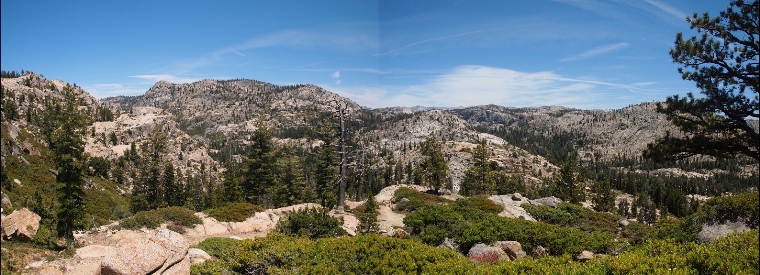
“Pop”
It was 9:15pm. The sun was barely down, I had been asleep for less than an hour and in that state between dreaming and wakefulness. “Pop”, the noise is unmistakable to most backpackers, the hollow pop of a bear canister. I ignored it until….. “whoosh”, “whoosh”, “whoosh”…… the loud huffing of a bear, sniffing around my bear canister. I ignored it until the about the 5th or 6th huff.
“Great”, I thought (a bit annoyed), “now I have to get dressed and chase this bear away”. I put on a shirt and long underwear, grabbed my headlamp and stuck my head out of my tent. I momentarily blinded myself as the headlamp flashed and reflected off the outside of my tent. (That will teach me to put the headlamp on my head instead of trying to use it as a flashlight.) It had taken me a couple of minutes to find my cloths and get dressed but in that time the huffing had stopped and the bear apparently had moseyed off or at least moseyed behind a rock where I couldn’t see it.
The rest of the night proceeded without incident but I stayed dressed “just in case”. It was the first time that I’ve been visited by a bear in the backcountry. I thought about that for a bit the next morning. Backcountry newbies would probably be excited or perhaps even scared. I was simply annoyed; I had just fallen asleep.
That was my second night at Deer Lake. I’d made the 6 hour trek from the Crabtree trailhead the day before, taking the “high” road aka PC-4 or 20E16- the trail to Piute Meadow via Camp Lake and then up past Piute, Gem and Jewelry Lakes to Deer. It’s an 11 mile trip that rises and drops, rises and drops and then continues to rise until it reaches Deer Lake. It turned out to be a 12 mile trip for me as I dropped my map and had to back track to the ridge above Piute Meadow.
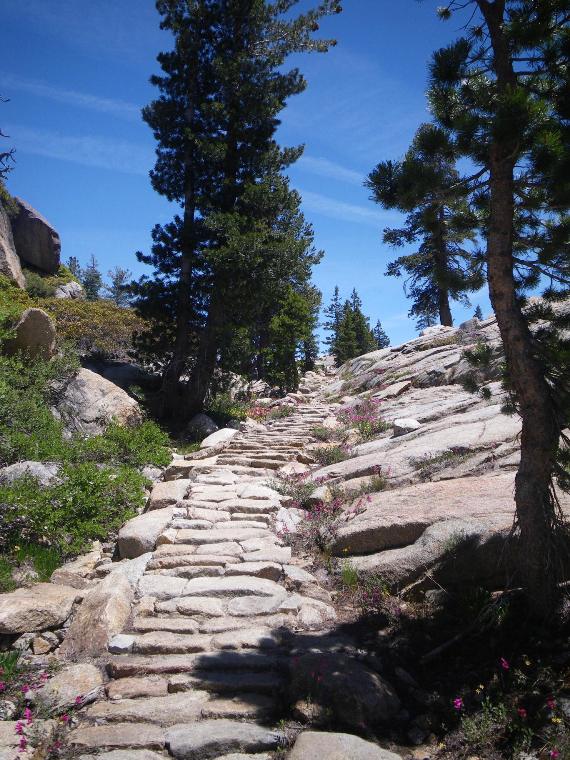
Fortunately, I’d been wary of this happening. I’ve recently purchased an Osprey Exos 58 and suspected that the elastic on the pocket on the chest strap might actually push my map out of the pocket. Seems I was correct and caught it before I’d travelled too far. Unfortunately, I only discovered it when I was in the valley of Piute Meadow and had to back track back up to the ridge.
The beta on the way in was pretty much unanimous- the fishing was great but the mosquitos where horrible. One guy even went so far as to suggest that I skip fishing the Buck Lakes. “Don’t go,” he said, “the mosquitos are so bad you can’t even piss.”
I made a mental note to push my visit to Buck Lakes back from the second day, to the last day of my journey in an attempt to give the Devil Bugs time to thin out.
I received some other actionable beta from folks on the trail- fishing was best at Deer and Wood Lake or Lower Buck and Wood Lake depending on whom I spoke with. When I queried a bit further “good in terms of size or numbers?” One fly fisher said “both” when speaking of Lower Buck and Wood Lake.
Another fly fisher said the fish at Deer Lake were feeding on big brown dragonflies. I didn’t bring any dragon dries, only bugs that would imitate dragon nymphs in a pinch. He hadn’t brought any dragons either but lucked out he said. They took his hoppers just fine. I didn’t have any hoppers, either. “I’ve got some large stimulators. Maybe those will work”, I replied. He was skeptical.
If it’s one thing that the Emigrant Wilderness is not at this time of year, is deserted. I ran into plenty of folks on the way in. The plan was to hike into Deer Lake and use that as a base camp to fish Deer, Upper and Lower Buck Lakes, Wood Lake and Long Lake. “Are there even fish in Long” one fly fisher asked? I didn’t know. I knew there were fish at one time- large fish but supposedly poor fishing and requiring annual plants to sustain. At Deer and Wood Lakes, I expected numbers and at the Buck Lakes- size. Long was going to be a mystery- it could be amazing or not; but, since it was barely 30 minutes from Deer, following the creek, it was worth a peek.
I set up camp on the far side of Deer Lake, an area of the lake where one of the fellows hiking out said the mosquitos were “bearable.” He was right. I’d walked a good portion of the lake and they were lighter on the far side. At least they were until….. just before dark…..
I’d set up my camp just above the lake, high enough to catch some wind and eliminate some mosquitos but low enough to be somewhat safe in a storm- as safe as one can be camping so close to water…..
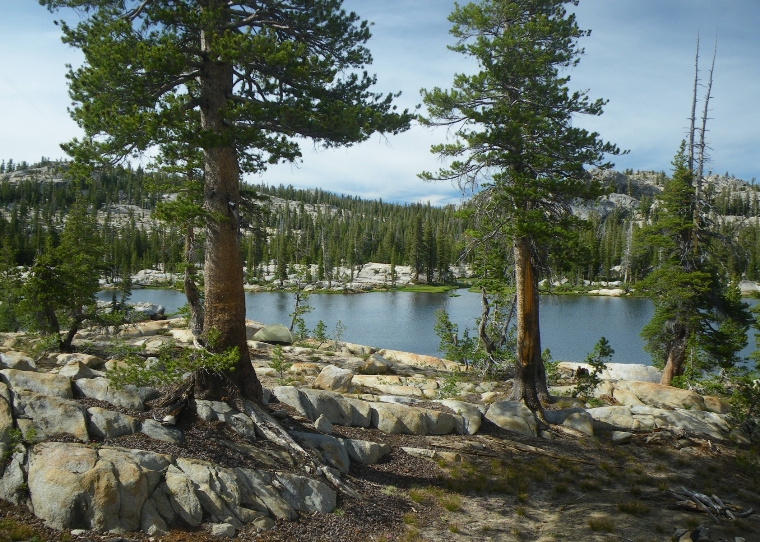
That first night as the shadows grew long; the fish went bonkers, feeding freely along the surface. I tied on a size 12 ant and was quickly getting strikes. I’d caught my first fish earlier when I brought my rod down to the water with me to fill my collapsible Platypus bottle with water. I brought it “just in case” there were cruising fish just below camp. There was one. I crept to the edge, made the cast, caught and released the 10 inches fish before filling my water bottle and returning to camp to eat dinner. After dinner I had planned to spend the rest of the evening fishing. The Devil Bugs had other plans for me.
Perhaps it was actually hatching mosquitos that had the fish in such a frenzy. I’m not sure but where there were few mosquitos at the water’s edge earlier, there was now a swarm. It was bad. Not the worst I’ve experienced, that would have been at the top of Brown Bear Pass several years earlier but bad enough that I was starting to have an allergic reaction to the bites. I can generally ignore the bugs and their bites but if there are enough of them, I start to have a reaction. I could feel it coming on. “Just one more fish and I am out of here!” I said to myself. It seemed like “that fish” took forever to catch. My hands were uncovered; I was constantly fidgeting as I tried to smash the ones that successfully bit me and avoid the others. As a consequence, I missed several strikes.
I slept soundly that night and easily adopted the sleep when the sun goes down and wake when the sun rises cycle. I thought a lot about the hike in- about Camp Lake and the freely feeding fish I saw there. A welcome sight for sure. I thought about the folks I met on the way in, about the alternate routes I could have taken to hike in and how at Piute Meadow, 3 or 3 and half hours into the hike I couldn’t help thinking “if I had run, I’d be there by now…..”

Deer Lake is beautiful. The water was clear and the lake was a mix of long flats that reached out to mid-lake island boulders with deeper water and drop offs. It seemed like a good lake for both shallow water sight fishing and deep water prospecting. I chose the former as the fish were pretty active for most of the day. From my camp, I fished clockwise around the lake and found it a bit schizophrenic. It seemed like every 200 meters the fish would demand a different fly. The fishing would be consistent with say a black ant on one portion of the lake but that same pattern farther down the lake would be ignored and the fish would only take a size 16 black gnat. Move again and it had to be a size 12 calibeatis.
There was one bug that seemed to be a universal. It didn’t matter where on the lake I was. If a big brown dragon fly flew close enough to the water, the fish would break away from whatever they were doing- rooting around in the muck for nymphs, chasing damsel flies, whatever it was and make a beeline to that bug. Jettisoning themselves clear out of the water in an attempt to catch the dragons mid-flight.
With no proper Dragonfly dry flies, I started by tying on a size 12 Prism Stimulator. The Prism Stimulator is tied like a standard Stimi but with a body that contains several different colored strands of reflective dubbing. In the air it looks like a bluish green but has many different colors across the spectrum.
“I probably need something bigger and more brown” I thought. I didn’t have anything brown but I did have something bigger- much bigger, October Caddis bigger. For years I’ve carried around some October Caddis sized Stimulators, a remnant from when I used to fish the Upper Sac each fall for October Caddis. I can’t remember what size these were? 4? 6? Who knows? I had one really big one and 3 that where the next size down. Surprisingly, the fly turned over well cast on my 4wt with 5x leader.
My first chance to fish the big bushy bundle of elk hair was on the bank closest to the trail. I was walking around a small cove heading to the inlet when I saw a fish, that likely went 12 inches, cruising toward shore behind me. At this point, landed enough fish between 8 and 10 inches that I was only casting to fish that appeared 12 inches or larger. I quickly turned around, pulled line off my rod and made the cast. The fish quickly accelerated toward the fly but before he could strike, another smaller fish intercepted it. I released the fish and continued along the bank to the inlet.

The inlet was largely devoid of fish and this made me careless. Walking upstream along the inlet, looking for a place to cross, I spooked the largest fish I’d see this trip. My guess was that it topped out at about 16 inches. Finding a place to cross I made my way back to mouth of the stream. Here the conditions where perfect. A slight undercut bank, a bit weedy and a breeze blowing bugs into the bank and against the current. As I got to within 15 feet of the lake I could see fish holding mid stream and so placed several casts to the near bank, looking for bigger fish. My casting had been a bit rusty early on but after couple of hours on the lake my accuracy improved and I was placing the fly just inches off the weed line. It was textbook. I caught and released a fish. Walked up the bank 10 or so feet, made another cast, caught and released a fish and repeated this another two or 3 times. Simply textbook and super cool to be accurately casting this huge dry fly, just inches off the bank and picking up fish from 10 to 13 inches. Girth wise, they were some of the better fish I’d caught up to that point. I continued to fish the Stimulator until I finally found the “big fish” water.
All things being relative, the fish in this section of the lake were on average a few inches larger. I suspect that I hooked into several 14 inches plus rainbows but will never know as I broke several fish off. In fact, I broke more fish off during this trip than during all of the last two years, to which I chalk up to a bad spool of tippet. Either that or I was getting so many strikes that the tippet was beginning to fray. This is where the Stimulator came into it’s own. These bigger fish wanted it and wanted it bad. The water was clear enough that I could see them approach and at times, they would turn and reject the fly at the last minute but when they did so, I found that I could induce a strike simply by pulling the fly under the surface. The pattern became a simply one. Spot a fish, cast the fly in its path and wait and watch. If the fish rejected the fly or didn’t strike because the cast was off, pull the fly under and give a long pull. If the fly hadn’t been taken by the fifth pull (which was unlikely) recast. It would turn out that this pattern worked on both Deer and Wood Lake, even when I lost the largest fly and had to fish the flies a size smaller.
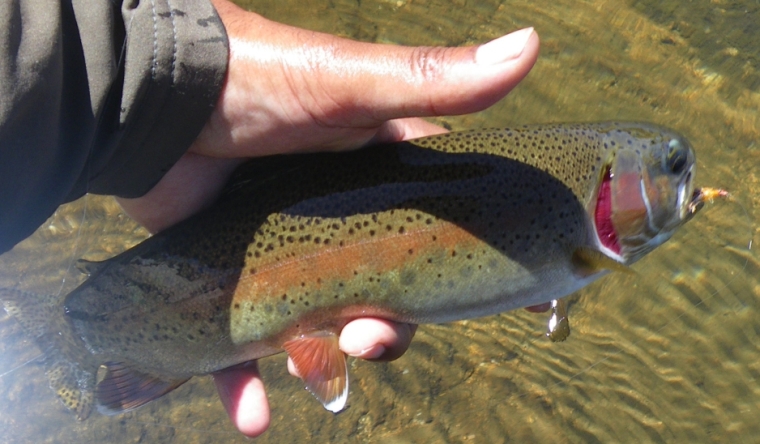
Tuesday I had originally planned to fish Buck Lakes but, given the mosquito situation, I decided to visit Buck Lakes on Thursday and instead head to Long Lake. Buck was going to be big fish water for sure but would be more pleasant if I could give the mosquitos a little time to work through their life cycle. It was a cross-country route to Long Lake from Deer. Simply find the low point between the two lakes and head in that direction. In worse case, follow the outlet stream to its origin.
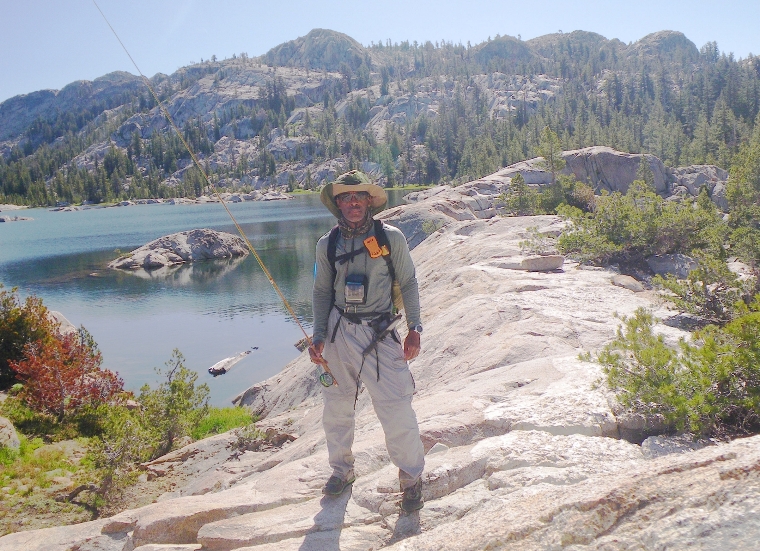
Long Lake was amazing. Beautiful grassy tarns intermixed with large granite boulders along the water’s edge. The calibeatis population was the largest I’ve seen anywhere. They were swarming as bad as the mosquitos were that first night at Deer and swarming all over me. I had dozens landing on me as I hiked the shoreline looking for fish. Unfortunately, I found no fish- not in the shallows near the outlet dam nor in the deep drop offs along the boulders nor in the boulder laden inlet stream. A carpet of Calibeatis on the water and nary a fish to care.

I searched Long Lake for about an hour and half, long enough to walk from the outlet dam to the trail to Wire Lakes on the inlet shore. It was all off trail, boulder hoping. I decided to head to Wire Lakes because…. Why not? I’d never been. I love the Emigrant and want to see as much as of it as possible. I vaguely remembered that one of the Wire Lakes might still hold fish (and I was thinking that it was the last lake) but couldn’t recall for sure. Again, I’d go and find out.
I only had time to fish the first Wire Lake. Barometric pressure was dropping and it looked like a storm might come in. I wanted to be closer to camp if one did. Wire was beautiful- dark with lots of structure and woody debris. I ate lunch on a rock several feet off shore and then walked the entire shoreline looking for active fish. Deep, dark and woody, it was a perfect brook trout prospecting lake but from what I’ve seen online since my return, those fish faded in the absence of stocking. What a shame.
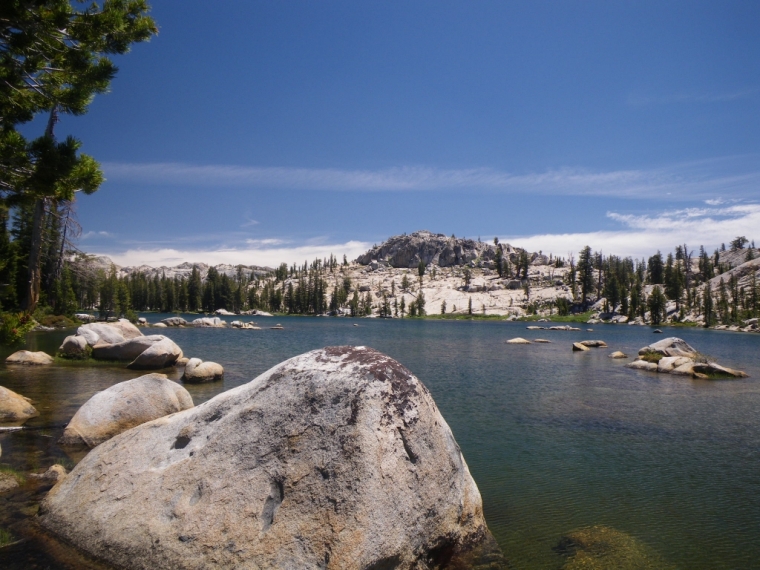
I returned to Deer in late afternoon and fished the deeper water as I returned to my campsite. I didn’t fish that evening, instead choosing to watch the sunset.
The bear didn’t leave much sign of its visit. I had placed heavy rocks on the bear canister. Rocks the bear could have easily knocked over if it had wanted to but it apparently didn’t. There was a possible paw print by my tent (maybe the bear was actually smelling me and not my canister) and a cleaner print outside camp. In fact, if I hadn’t been wide-awake to hear the huffing and looking for bear-sign the next morning, I wouldn’t have known the bear was there.
That morning I headed to Wood Lake, a quick down hill trek that begins winding through a slightly marshy knoll, descends steeply down some granite single track and intersects with a small trail at the lake which follows the lake counter clockwise to Lower Buck Lake. Wood Lake is essentially two lakes, maybe three, with a long, wide slow channel between. At the lake the mosquitos descended on me immediately. There would be no standing still here. I had to make a choice, fish clockwise around the lake or counter clockwise. Initially I was going to fish clockwise, so that my casting hand was over the water and I was looking into the sun. The fish activity however seemed to suggest that I fish counter clockwise. Not that there were necessarily more active fish in that direction. At first impression, the active fish seemed to be in the middle of the lake but the water in the counter clockwise direction seem to be a bit shallower and I figured I’d have a better chance to sight active fish. It didn’t take long to see that I was correct. I quickly came across an expansive flat that reached into the middle of the lake. I could see footsteps where fishermen had waded out into the lake to cast to the fish that could be seen rising. I had decided to leave my waders at camp and hoped that the entire lake wouldn’t be one huge flat with fish only feeding at it’s outer edge.

It wasn’t. I climbed around a little outcropping and quickly found a fish finning around some fallen trees. The Stimulator went into action. I made the cast but missed the mark and the fly landed too far away for the fish to key on immediately. Concerned about scaring the fish with a re-cast, I waited and as the fish approached, initially uninterested in the large floating fly, I pulled it under the surface. Fish On! A hot fish too and as large as anything I landed at Deer Lake. In fact, I found that on average, the active fish at Wood Lake were larger than the fish at Deer.
I released that fish and quickly found another, about 10 inches and then began to search the lake and sight cast to fish12 inches plus. There were plenty of active fish. On the backside of the lake, the trail to Lower Buck Lake follows the shoreline high above the bank. I had just climbed up to the trail, over rocks and through brush and was heading down the trail when I came to a large rock on the edge of a drop off. A large, easily 14 inches plus fish was quickly making its way over the drop off to the rock. If the fish made it to the rock before I could make the cast, I would lose my chance. I didn’t have time to run down to the bank so I made the cast from the trail. I stripped line off the water and high above the bank shot out the cast. I’d only get one cast.
At first I thought the cast was going to scare the fish or that I’d miss its feeding window. The fly landed several feed in front of the fish and instead of turning away in fear, it accelerated and slammed the fly, coming out of the water as it rolled. I stripped line furiously as I ran down to the bank, trying to keep the line tight. Alas the combination of the fish thrashing and my bounding down the bank must have introduced enough slack in the line to release the fish. The largest fish of the trip, slipped away. How cool is that! Big fish, tough situation, one cast to make or break and everything comes together. Landing the fish would have been nice but the excitement always comes in the sighting and fooling the fish and less so the handling.
Fishing in the long wide channel between the larger portions of the lake was a bit different. The fish weren’t as willing to come to the surface for a fly and the water was darker so the fish were harder to see. Fortunately, they were cruising high enough in the water column that I could make out their silvery bodies.
Memories of fishing and tying muddler minnows as a younger fly fisher gave me the idea to fish the Stimulators sub-surface as I did. Here in this slow moving, dark water, it was the perfect tactic. No pretense of sight fishing a dry here. I intentionally water logged the fly so that it would sink. It was a mix of sight fishing and fishing the water and the strikes were aggressive.
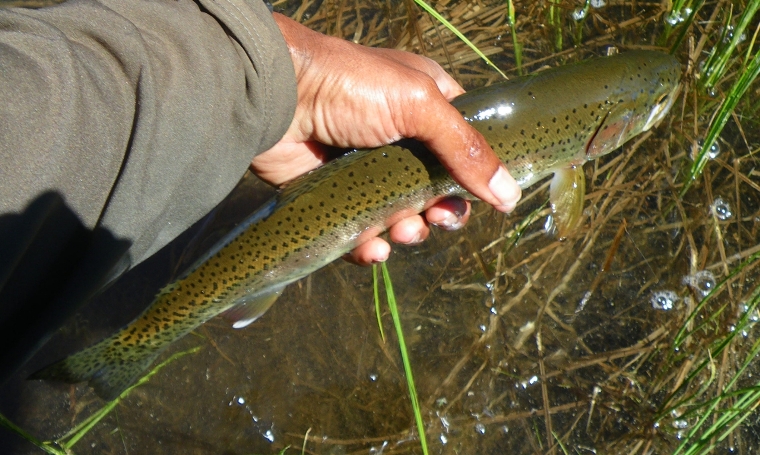
The “other” portion of the lake at the end of the channel was essentially two lakes or is likely two lakes in late summer. The trail to Lower Buck Lake travels across a sandbar in several inches of water that I have to imagine dries to create a small berm between the two in summer. I continued down the bank instead of crossing, which allowed me to fish the larger and from what I could see, deeper water.
A fisherman’s trail continued along the bank and up and over a granite outcrop on the edge of the water. I caught a few fish before eating lunch at the top of the granite. I ate and watched the fish cruise along its edge. The most exciting fishing on this portion of the lake was from this outcropping. The water was deep but my position was high above the lake, easily 15 feet or more, providing me with a good view of the surrounding water. Large fish would cruise in from the flats, along the granite’s edge and disappear into the deeper water. I was able to drop the Stimulator down on several fish in quick secession. It was exciting, fast action.
I continued on the fisherman’s trail past several large campsites around the lake until coming to another even larger granite outcropping on the other side. This was a significant barrier and the climb over would have been a significant effort, so I chose instead to backtrack and rejoin the Bucks Lake trail to the opposite side of the lake. I fished the section was more shallow and I fished it for a very short period, more concerned about the storm clouds that seemed to be rolling in than catching more fish. It was still early afternoon but I had had a pretty full day. The barometric pressure was dropping and the clouds seemed to be directly over the first lake so I headed back, fishing a bit as I made my way.
When I reached the first lake the sky was clear but the storm clouds appeared to be moving in the direction of Deer Lake so I headed back to camp. I reached camp mid-afternoon and spent the rest of the afternoon and early evening just watching the sky. Thick clouds moved in but the barometric pressure seemed to steady. I went to bed that night to a red sky. Normally a good omen but since the weather was coming in from the West, I suspected not.
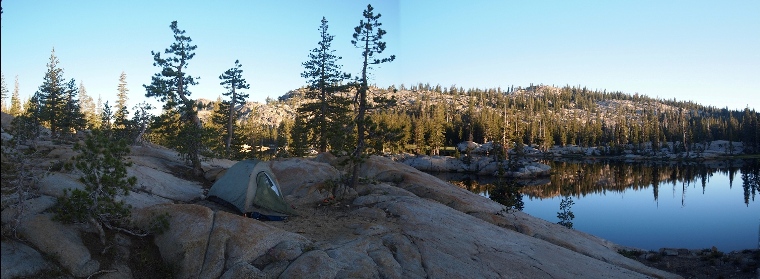
That night I didn’t sleep much. The wind had picked up and was whipping my tent around. I was camped on a sandy flat on top of some granite, which didn’t lend itself to the best tie down points. They were good enough to keep the tent from blowing away but not so taught as to eliminate the loud rippling of my rain fly. At about 12:30 AM I looked out and the cloud cover had given way to a clear starry sky. I anticipated fishing the Buck Lakes the next morning and figured the worse was over.
The wind continued. Several bears could have walked up to my tent that night and I wouldn’t have known. At about 2:30am it started to rain. “No problem”, I thought. “It’ll probably let up at first light”, as early morning storms often do. First light occurs around 5AM and with it, I was anticipating the cessation of the rain. When that didn’t happen, I stuck my head out of my tent to assess the situation.
“Wow, this is nasty.”
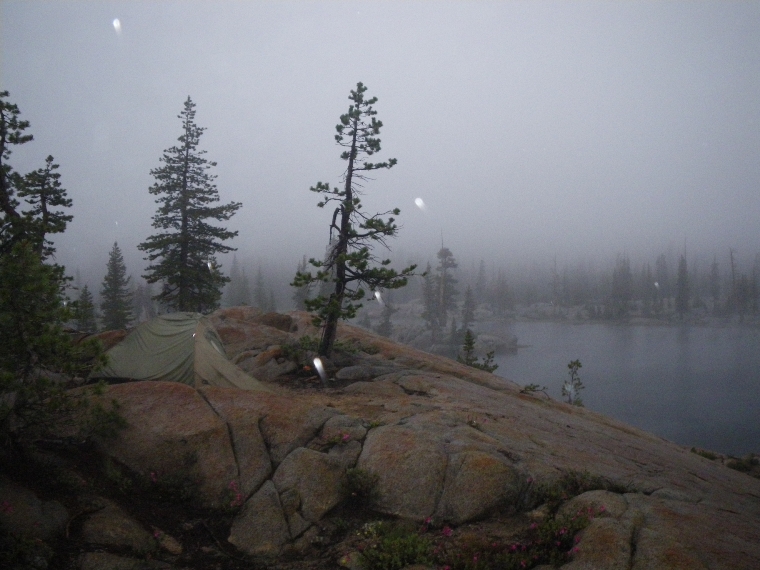
The cloud cover had dropped, the temperature had dropped and the wind was still blowing. It was a foggy, freezing rain. Time to go. One of the things I dislike most about California, Northern California, is it’s winters. I hate being cold and wet. On the East Coast, we do cold and we do wet, but usually not at the same time. Cold and dry and warm and wet I can tolerate, even enjoy (there’s nothing like a summer shower in Pennsylvania or Virginia or a cold, snowy afternoon in Connecticut). I especially hate being cold and wet while backpacking because it means I have to clean and dry all my gear when I get home. Everything gets wet in rainy weather no matter how covered it is or how deep in your pack you think it’s buried. It only takes a little water to necessitate a complete cleaning and airing out.
It was the penultimate day of my trip, so it made sense to pack up and leave, not knowing if the storm was going to continue. I was packed up and was in my rain gear heading out of camp by 7am.
Conditions were worse than I thought and continued to deteriorate. Just past Jewelry Lake it was clear that I was underdressed and in danger of hypothermia. The dilemma- stop and put on an extra layer, soaking my dry torso in the processes or continue on, eating and moving faster hoping to stoke my body’s internal flames. I put it off for as long as I could but wisely pulled off the trail and put on my down jacket. This helped quite a bit but it’s amazing how much heat is lost when your thighs are cold and wet. Next time I’m in this situation, I’ll be sure to put on my long underwear before leaving camp……

By Piute Meadow the weather had improved quite a bit. The temperatures had come up, the steady rain alternating with intermittent misting. At Camp Lake the cold rain had stifled the rising fish I had seen on my way in. A long time favorite, I decided not to fish Camp. It was good to see the fish had returned and I’ll be back to fish it later in the summer. The weather improved slightly at the trailhead, no doubt because of the lower elevation and on my way through the Central Valley I was surprised to see how overcast it was heading west toward home.
With the conclusion of this trip I’ve visited all of the Emigrant’s best known lakes save for the Buck Lakes. There are plenty of lesser known lakes however, more than enough to fuel my adventures for years to come.
